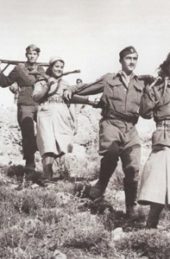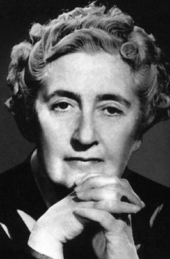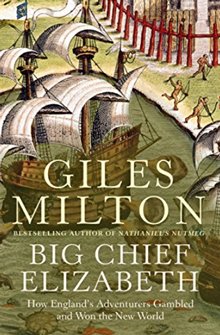Articles
Click on the links below to read the full article












Author Interview(s)


 Giles, Paradise Lost is a riveting account of the events in September 1922 when the now Turkish city of Izmir, then Smyrna, was partially destroyed when Turkish forces entered the city. It is described on the front cover as ‘Islam’s city of tolerance’. What was Smyrna like prior to the events of September 1922?In the early 20th century, Smyrna was an extraordinarily cosmopolitan, multi-ethnic, and tolerant city – so much so, that the American expatriate community named their district of the city ‘Paradise’ (hence the title of my book). They knew of nowhere in America that displayed such an open-minded spirit.Smyrna was also unique in being the only major city in the Middle East with a majority Christian population.It was divided into quarters, with specific populations living in each quarter. The city was dominated by the Greeks, who numbered 320,000 and had a virtual monopoly on the lucrative trade in figs, sultanas, and apricots. Greeks also owned many of the city’s major businesses.The second largest population was the Turks, who numbered 140,000; they were mostly artisans and craftsmen who lived in the city’s poorest quarter. Despite their humble status, Smyrna’s governor was always Turkish, as befitted one of the principal cities in Ottoman Turkey.Smyrna was also home to a vibrant and wealthy Armenian community, and a smaller Jewish population. There were also European merchants, often insurance brokers and bankers, whose prosperous businesses were centred on Frank Street, the city’s principal artery.The American quarter, Paradise, was smaller but nevertheless important, for it was home to influential educational and humanitarian institutions. Americans also owned the highly profitable Standard Oil Company.Lastly, there were the Levantines, the wealthiest and most fascinating community in Smyrna. They were descendants of European merchants who had married into the Greek and Armenian communities. Rich, powerful and polyglot, they spoke five or six languages and owned the city’s most successful international businesses. The grandest Levantine dynasties lived in palatial villas in the suburb of Bournabat, where they would host splendid cocktail parties in their private botanical gardens.Why did you want to write the story of this huge event in 20th century European history?Smyrna in the early years of the twentieth century was like a mirror of our contemporary cities - a melting pot of nationalities and religions. I was interested to learn how a city that functioned so smoothly could be so dramatically torn apart. It begged an important question: could our own contemporary cities suffer a similar fate?The destruction of Smyrna is also crucial to our understanding of the 20th century world, yet it remains almost a wholly unknown chapter of history. Who knows about the Greek invasion of Turkey in 1919? About the mass exchange of populations in 1923? These were events that transformed the lives of millions of people – almost always for the worse.Yet more tantalising was the invidious role played the great powers, notably Britain and America, who were to display a callous disregard for the lives of the refugees trapped on the quayside of Smyrna, even though they had done so much to inflame the situation.Why were Greece and Turkey at war?In the aftermath of the Great War, Greece’s Prime Minster was a brilliant individual named Eleftherios Venizelos. His central thesis – his Megali Idea –was to reclaim all the ancient Greek lands of Asia Minor, lands that currently fell within the frontiers of the crumbling Ottoman empire. Deploying charm and guile, he persuaded the Great Powers to allow him to occupy Smyrna, with its majority Greek population, in 1919.When the Turks fought back, Venizelos was obliged to push his troops into the hinterland around Smyrna. But they still came under attack, requiring him to push them even further east. Over the next three years, the Greek army drove ever deeper into Anatolia as it sought to create a safe buffer zone around Smyrna.The Greek army was victorious for as long as the Great Powers provided it with weapons. But when Venizelos lost power, and the detested King Constantine returned to the Greek throne, the flow of arms ceased. The Turkish nationalists seized their opportunity, crushing the Greek army and advancing towards Smyrna.There was a western military presence at the port, in the form of 21 British, American and French ships. Why did they not intervene? The destruction of Smyrna could have been prevented by the Allied warships in the bay of Smyrna. The Great Powers could also have prevented the massacre that followed. But the commanders of those Western warships were under strict orders not to intervene in the unfolding crisis.Why? Because politicians in London and Washington knew that the Turkish Nationalists had won the war against the Greeks and they were already eyeing up the rich trade deals they were hoping to conclude with Mustafa Kemal (later Ataturk). They didn’t want to be seen to be helping tens of thousands of defeated Greeks and Armenians trapped on the quayside.There is some dispute over who was responsible for the burning of Smyrna, and debate has raged in the 100 years since – where does that responsibility lie in your view? The great fire of Smyrna remains a controversial subject. Even today, Greeks and Turks violently disagree on who set fire to the city.I had an open mind when researching the book. I was particularly interest in the eyewitness accounts of the Levantines and Americans because these communities were rarely partisan. They simply recorded the facts.I unearthed scores of their testimonies – recorded in diaries, letters and memoirs – which left me in no doubt that Turkish soldiers willingly and deliberately set fire to the city. One of the most powerful accounts was by Miss Minnie Mills, head of the American Collegiate Institute. She watched Turkish soldiers dousing Armenian houses in petrol and then setting fire to them.It is notable that the fire started on a day when the wind had changed direction. This meant that the Greek, Armenian and European districts of the city were in grave danger of being engulfed in flames, whereas the Turkish quarter was likely to remain untouched. This was indeed what happened.The book was published in Turkey, which in itself is remarkable given your criticism of Turkish forces. What was the reaction there? My Turkish publisher was an enlightened individual. He told me he thought it was important for the book to be published in Turkish, even though he did not agree with my conclusions. He even got me an invitation to the Istanbul book fair.The book has received a great deal of criticism in the Turkish press and on the Turkish internet. I was warned not to read some of the more offensive and threatening comments.One man, Asa Jennings, carried out an incredible act of heroism. How did he manage to save 350,000 people? There are occasions when history throws up the most unlikely heroes. Asa Jennings is one such individual. An American missionary in Smyrna, Jennings worked for the local branch of the YMCA. Shy, and slight of stature, he had achieved little of note in his adult life. He might easily have fled Smyrna when Turkish troops began destroying the city, for American nationals were being evacuated to the US warships anchored in the bay. But Jennings was appalled by the brutal scenes taking place on the quay of Smyrna and decided to act – in spectacular fashion.Acting with uncustomary bravado, he pretended to be a high-ranking American official in command of the (non-existent) Western rescue mission. In this guise, he contacted the Greek government in Athens and ordered them to give him immediate command of the 25 Greek vessels standing idle off the coast of Smyrna. To his astonishment, the Greek ministers agreed.Over the days that followed, Jennings oversaw the rescue of hundreds of thousands of refugees. They were plucked from the quayside of Smyrna and taken to safety on nearby Mytilene island. It was to prove one of the greatest rescue missions of the early 20th century.If you were to write a new edition, is there anything you’d change?Yes. A couple of years after publication, I stumbled across a highly detailed account of the Smyrna inferno written by Miss Minnie Mills, whose shorter testimony had already proved invaluable. Eight pages long, this unique account covers events from 5th to 13th September.I found it in the archives of the American College of Greece where it had lain – forgotten - for more than eight decades. It begins: ‘I saw a Turk officer in uniform coming out of a house, taking with him tin containers full of petrol…’ Miss Mills was in no doubt that the Turkish army deliberately torched the city.We are at the 100 year anniversary. Given the mass population shifts in the wake of the disaster, do feelings remain raw in Greece and Turkey?The destruction of Smyrna remains an extremely sensitive subject in both Greece and Turkey. I was recently asked to participate in a Greek TV documentary about the events of 1922. Our TV crew was one of many Greek teams attempting to make a programme focussed on the anniversary.All of these teams – with the exception of ours – were refused permission to film in Turkey. Erdogan’s government is committed to ensuring that the anniversary commemorations will be as subdued as possible.
Giles, Paradise Lost is a riveting account of the events in September 1922 when the now Turkish city of Izmir, then Smyrna, was partially destroyed when Turkish forces entered the city. It is described on the front cover as ‘Islam’s city of tolerance’. What was Smyrna like prior to the events of September 1922?In the early 20th century, Smyrna was an extraordinarily cosmopolitan, multi-ethnic, and tolerant city – so much so, that the American expatriate community named their district of the city ‘Paradise’ (hence the title of my book). They knew of nowhere in America that displayed such an open-minded spirit.Smyrna was also unique in being the only major city in the Middle East with a majority Christian population.It was divided into quarters, with specific populations living in each quarter. The city was dominated by the Greeks, who numbered 320,000 and had a virtual monopoly on the lucrative trade in figs, sultanas, and apricots. Greeks also owned many of the city’s major businesses.The second largest population was the Turks, who numbered 140,000; they were mostly artisans and craftsmen who lived in the city’s poorest quarter. Despite their humble status, Smyrna’s governor was always Turkish, as befitted one of the principal cities in Ottoman Turkey.Smyrna was also home to a vibrant and wealthy Armenian community, and a smaller Jewish population. There were also European merchants, often insurance brokers and bankers, whose prosperous businesses were centred on Frank Street, the city’s principal artery.The American quarter, Paradise, was smaller but nevertheless important, for it was home to influential educational and humanitarian institutions. Americans also owned the highly profitable Standard Oil Company.Lastly, there were the Levantines, the wealthiest and most fascinating community in Smyrna. They were descendants of European merchants who had married into the Greek and Armenian communities. Rich, powerful and polyglot, they spoke five or six languages and owned the city’s most successful international businesses. The grandest Levantine dynasties lived in palatial villas in the suburb of Bournabat, where they would host splendid cocktail parties in their private botanical gardens.Why did you want to write the story of this huge event in 20th century European history?Smyrna in the early years of the twentieth century was like a mirror of our contemporary cities - a melting pot of nationalities and religions. I was interested to learn how a city that functioned so smoothly could be so dramatically torn apart. It begged an important question: could our own contemporary cities suffer a similar fate?The destruction of Smyrna is also crucial to our understanding of the 20th century world, yet it remains almost a wholly unknown chapter of history. Who knows about the Greek invasion of Turkey in 1919? About the mass exchange of populations in 1923? These were events that transformed the lives of millions of people – almost always for the worse.Yet more tantalising was the invidious role played the great powers, notably Britain and America, who were to display a callous disregard for the lives of the refugees trapped on the quayside of Smyrna, even though they had done so much to inflame the situation.Why were Greece and Turkey at war?In the aftermath of the Great War, Greece’s Prime Minster was a brilliant individual named Eleftherios Venizelos. His central thesis – his Megali Idea –was to reclaim all the ancient Greek lands of Asia Minor, lands that currently fell within the frontiers of the crumbling Ottoman empire. Deploying charm and guile, he persuaded the Great Powers to allow him to occupy Smyrna, with its majority Greek population, in 1919.When the Turks fought back, Venizelos was obliged to push his troops into the hinterland around Smyrna. But they still came under attack, requiring him to push them even further east. Over the next three years, the Greek army drove ever deeper into Anatolia as it sought to create a safe buffer zone around Smyrna.The Greek army was victorious for as long as the Great Powers provided it with weapons. But when Venizelos lost power, and the detested King Constantine returned to the Greek throne, the flow of arms ceased. The Turkish nationalists seized their opportunity, crushing the Greek army and advancing towards Smyrna.There was a western military presence at the port, in the form of 21 British, American and French ships. Why did they not intervene? The destruction of Smyrna could have been prevented by the Allied warships in the bay of Smyrna. The Great Powers could also have prevented the massacre that followed. But the commanders of those Western warships were under strict orders not to intervene in the unfolding crisis.Why? Because politicians in London and Washington knew that the Turkish Nationalists had won the war against the Greeks and they were already eyeing up the rich trade deals they were hoping to conclude with Mustafa Kemal (later Ataturk). They didn’t want to be seen to be helping tens of thousands of defeated Greeks and Armenians trapped on the quayside.There is some dispute over who was responsible for the burning of Smyrna, and debate has raged in the 100 years since – where does that responsibility lie in your view? The great fire of Smyrna remains a controversial subject. Even today, Greeks and Turks violently disagree on who set fire to the city.I had an open mind when researching the book. I was particularly interest in the eyewitness accounts of the Levantines and Americans because these communities were rarely partisan. They simply recorded the facts.I unearthed scores of their testimonies – recorded in diaries, letters and memoirs – which left me in no doubt that Turkish soldiers willingly and deliberately set fire to the city. One of the most powerful accounts was by Miss Minnie Mills, head of the American Collegiate Institute. She watched Turkish soldiers dousing Armenian houses in petrol and then setting fire to them.It is notable that the fire started on a day when the wind had changed direction. This meant that the Greek, Armenian and European districts of the city were in grave danger of being engulfed in flames, whereas the Turkish quarter was likely to remain untouched. This was indeed what happened.The book was published in Turkey, which in itself is remarkable given your criticism of Turkish forces. What was the reaction there? My Turkish publisher was an enlightened individual. He told me he thought it was important for the book to be published in Turkish, even though he did not agree with my conclusions. He even got me an invitation to the Istanbul book fair.The book has received a great deal of criticism in the Turkish press and on the Turkish internet. I was warned not to read some of the more offensive and threatening comments.One man, Asa Jennings, carried out an incredible act of heroism. How did he manage to save 350,000 people? There are occasions when history throws up the most unlikely heroes. Asa Jennings is one such individual. An American missionary in Smyrna, Jennings worked for the local branch of the YMCA. Shy, and slight of stature, he had achieved little of note in his adult life. He might easily have fled Smyrna when Turkish troops began destroying the city, for American nationals were being evacuated to the US warships anchored in the bay. But Jennings was appalled by the brutal scenes taking place on the quay of Smyrna and decided to act – in spectacular fashion.Acting with uncustomary bravado, he pretended to be a high-ranking American official in command of the (non-existent) Western rescue mission. In this guise, he contacted the Greek government in Athens and ordered them to give him immediate command of the 25 Greek vessels standing idle off the coast of Smyrna. To his astonishment, the Greek ministers agreed.Over the days that followed, Jennings oversaw the rescue of hundreds of thousands of refugees. They were plucked from the quayside of Smyrna and taken to safety on nearby Mytilene island. It was to prove one of the greatest rescue missions of the early 20th century.If you were to write a new edition, is there anything you’d change?Yes. A couple of years after publication, I stumbled across a highly detailed account of the Smyrna inferno written by Miss Minnie Mills, whose shorter testimony had already proved invaluable. Eight pages long, this unique account covers events from 5th to 13th September.I found it in the archives of the American College of Greece where it had lain – forgotten - for more than eight decades. It begins: ‘I saw a Turk officer in uniform coming out of a house, taking with him tin containers full of petrol…’ Miss Mills was in no doubt that the Turkish army deliberately torched the city.We are at the 100 year anniversary. Given the mass population shifts in the wake of the disaster, do feelings remain raw in Greece and Turkey?The destruction of Smyrna remains an extremely sensitive subject in both Greece and Turkey. I was recently asked to participate in a Greek TV documentary about the events of 1922. Our TV crew was one of many Greek teams attempting to make a programme focussed on the anniversary.All of these teams – with the exception of ours – were refused permission to film in Turkey. Erdogan’s government is committed to ensuring that the anniversary commemorations will be as subdued as possible. Giles Milton is an acclaimed and bestselling historian and author of Paradise Lost: Smyrna 1922, the Destruction of Islam's City of Tolerance, which is highly recommended. You can hear a chat with Giles on Smyrna on the Aspects of History Podcast.
Giles Milton is an acclaimed and bestselling historian and author of Paradise Lost: Smyrna 1922, the Destruction of Islam's City of Tolerance, which is highly recommended. You can hear a chat with Giles on Smyrna on the Aspects of History Podcast.


















